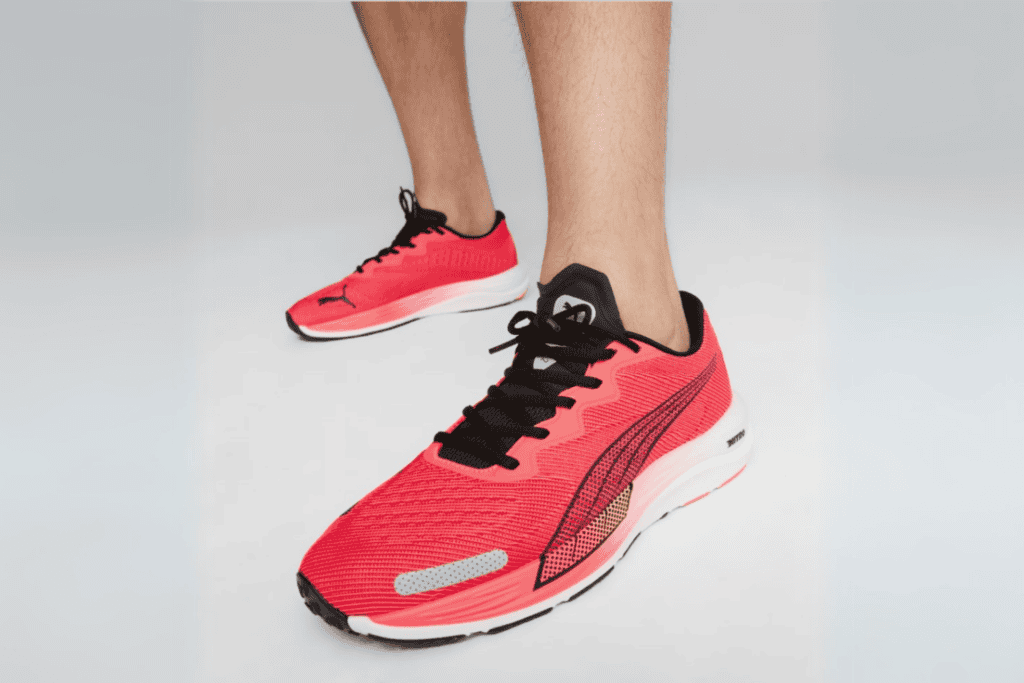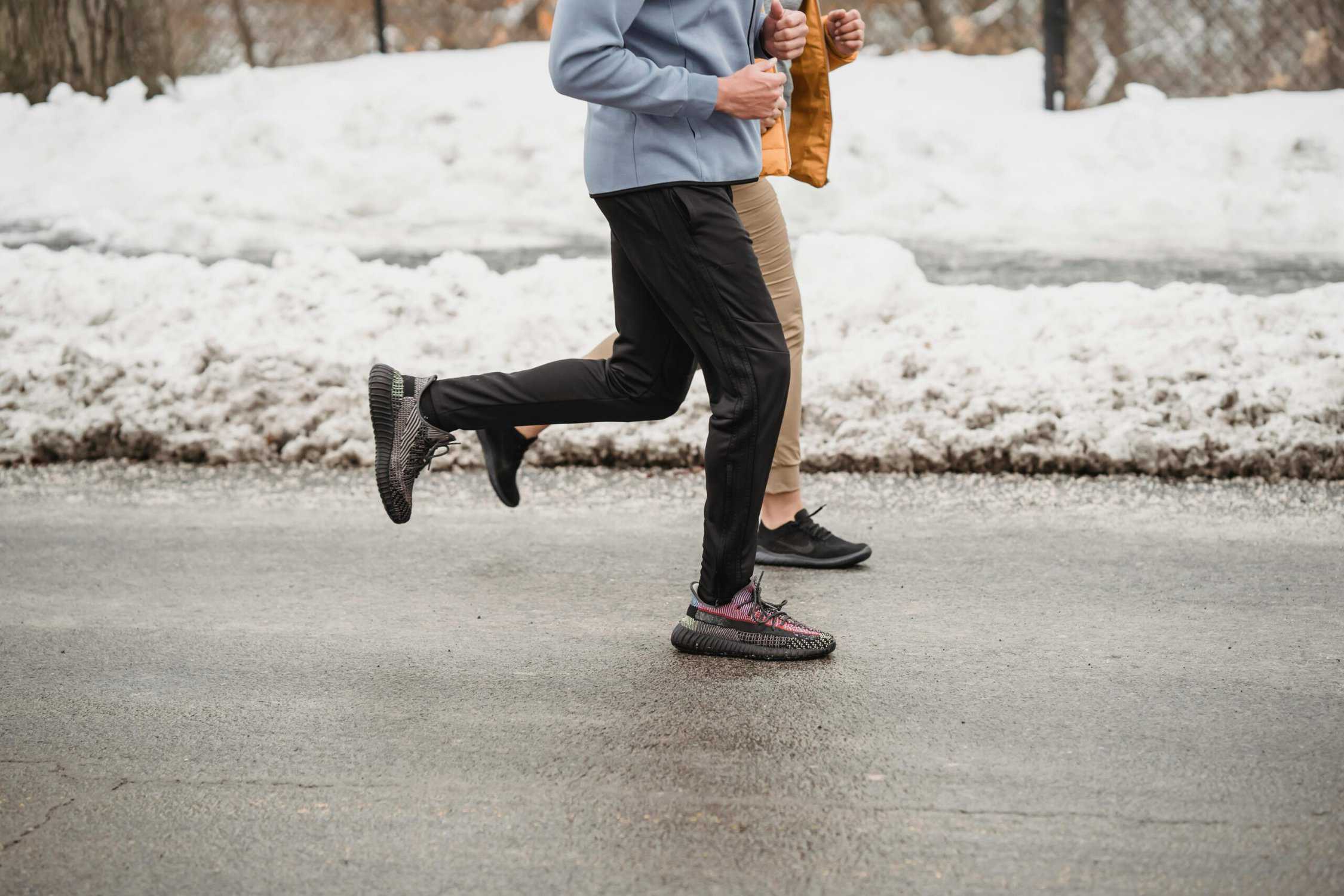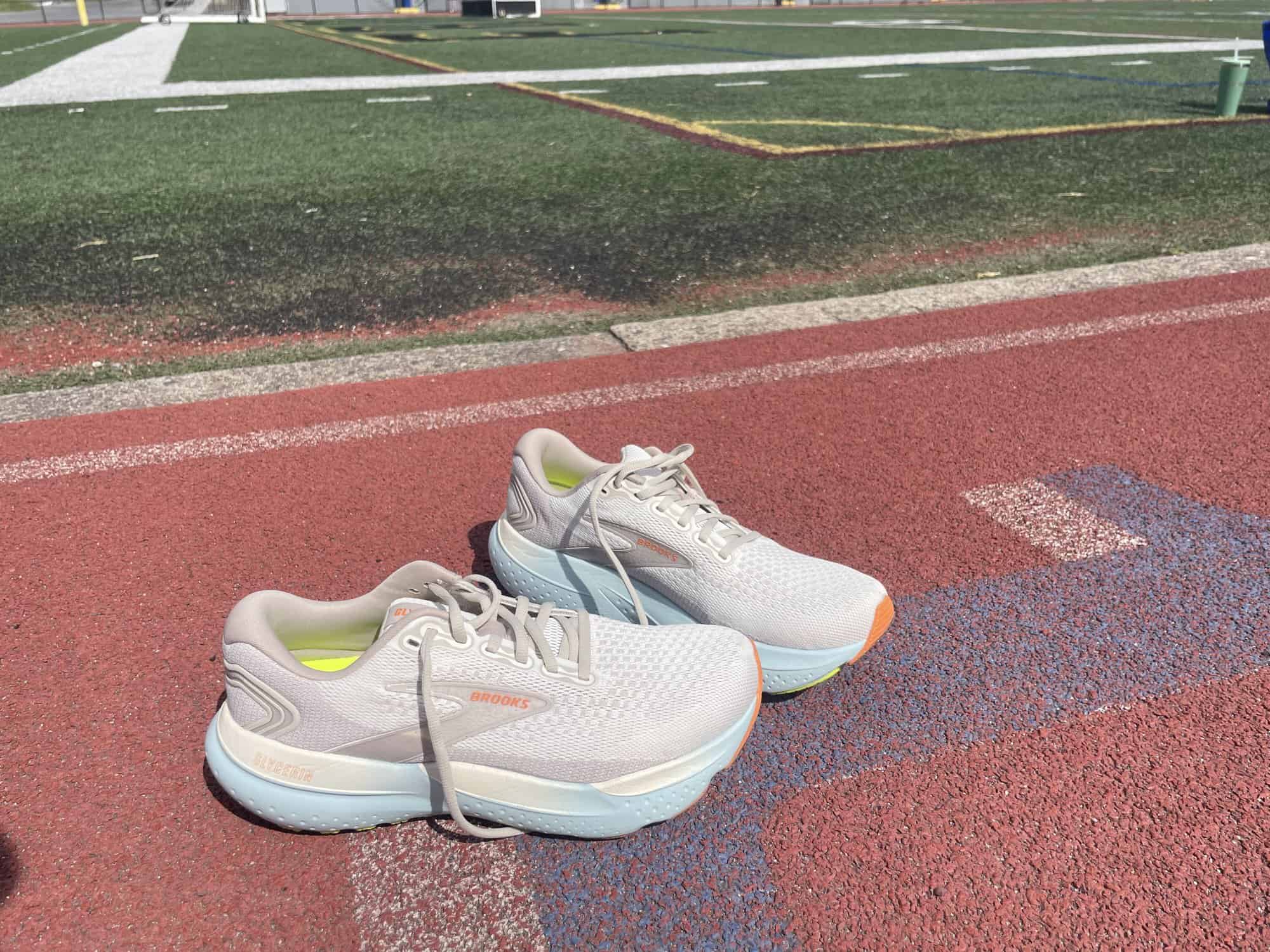Whether you are running your first half marathon or your 50th, a quality pair of running shoes is necessary to get you through training and race day.
Now, every runner has a different need in their half marathon shoes depending on your gait, cushion preference, and race goals. Some runners want one shoe to carry them through training and race day, while others want to minimize injury risk during training and then run fast come race day. Whatever your needs, we’ve got a shoe for you.
As a gear writer, I have tested hundreds of running shoes over the year and have worked as a fit specialist in running stores since 2017. I’ve also trained for and run many half marathons. In short: I know which running shoes are going to make you happy through months of training and the 13.1-mile distance come race day.
Best Half Marathon Shoes for Training and Racing
- Best Overall: Brooks Glycerin 21
- Best Budget: Puma Velocity Nitro
- Best Racing Shoe: Nike Alphafly 3
- Best Value: HOKA Clifton 9
- Best Lightweight Shoe: Hoka Mach 6
- Best Stability Shoe: Saucony Hurricane 24
- Best High Cushion Shoe: Saucony Triumph 22
- Best Trail Runner: Hoka Speedgoat 6

–
Editor’s note: We’ve listed two weights for each shoe; the first for the women’s model and the second the men’s.
–
Best Overall
Our Pick: Brooks Glycerin 21

Weight: 9.2-9.8 oz | Drop: 10mm | Cushion Level: High | Shoe Type: Neutral
Pros:
- Spacious toe box
- Very breathable upper
- Incredibly comfortable for long wear
- Soft and bouncy midsole without being bulky
Cons:
- Midsole foam may wear quicker for forefoot strikers
There is no single shoe perfect for every runner, the Brooks Glycerin 21 comes pretty darn close. This do-it-all shoe will carry you comfortably through every type of run during training and race day.
The Glycerin 21 offers a comfortable, plush ride without feeling bulky or heavy — a common issue with higher–cushion shoes. The nitrogen-infused foam makes it both light and bouncy underfoot, allowing some give without becoming muddy or too squishy.
Brooks may not be the flashiest brand, but their shoes are durable and versatile. The Glycerin has a soft, comfortable, and breathable upper with a padded tongue and heel cup for comfort and support. Its thick, grippy, full-coverage rubber outsole protects the midsole from abrasion and makes it reliable on a range of surfaces.
At $160, the Glycerin’s durability and multi-purpose design is worth the investment. It’s a great all-around training shoe – cushioned enough for long runs, light and responsive enough for speedwork, and comfortable enough for recovery.
As a bonus, I also love it as a walking shoe for recovery days.
If you’re an overpronator: The Brooks Glycerin 21 is a neutral shoe, so it won’t prop your arch up for overpronators. You can add insoles to the Glycerin 21, or, for the best stability shoe to run a half marathon in, I love the Glycerin GTS.
Read our full review of the Brooks Glycerin 21.
Buy It
Best Budget
Our Pick: Puma Velocity Nitro 2

Weight: 7.3-9.1 oz | Drop: 9 mm | Cushion Level: Medium | Shoe Type: Neutral
Pros:
- Affordable
- Lightweight
- Good ground feel
- Durable and grippy outsole
Cons:
- Not super cushioned
The Velocity Nitro 2 is a light and snappy shoe designed to handle the rigors of daily training. The Puma’s Nitro foam across the entire midsole gives it a light and cushy feel despite not actually having a ton of foam underfoot.
The shoe provides excellent grip — better than most on the list I would argue. It has a super durable rubber outsole covering almost the entire sole of the shoe with specific textures for better grip in strategic places along the side.
The upper is pretty standard but made with an engineered mesh, known for durability and breathability. It goes above and beyond the typical reflective elements with details that can be seen from every angle — a helpful feature if you often run in low light.
Considering most mid-models run around $150, an $120 trainer is a great deal for a quality trainer.
That said, if you’re prone to stress-related injuries and want a higher cushion model, or have significant arch collapse or overpronation, you’ll want a stability shoe. (For a similar feel, try the Nike Structure 25.)
Buy It
Best Racing Shoe
Our Pick: Nike Alphafly 3

Weight: 8.0oz | Drop: 8 mm | Cushion Level: Medium | Shoe Type: Carbon Plate
Pros:
- Light and fast
- Full-length carbon plate
- Breathable upper
Cons:
- Expensive (but aligned with other carbon racers)
- Not super durable over multiple races
The Nike Alphafly collection has long been a favorite of elites and amateurs alike looking to run faster at their race. While we can’t promise it will make you as fast as Kipchoge, it may very well help you drop some time. This shoe has the ideal combo of light, fast, and incredibly responsive.
The Alphafly 3 returns to the fast, bouncy experience that made the original iteration a cult favorite. It pairs ZoomX foam with Zoom Air units to give you a soft, high-cushion feel and a thin rubber outsole to provide grip without weighing it down.
This shoe also has a full-length carbon plate that helps propel you forward and roll through every step. The flared base at the toe and heel give you additional stability without affecting your gait.
The Flyknit upper is light and highly breathable while also offering a stretch-free supportive feel that keeps your foot secure in the shoe. It also features notched laces that lock together and prevent any slippage so you won’t have to adjust mid-race.
Wear this shoe on race day (while breaking it in on training runs, of course), and you’ll fly.
Buy It
Best Value
Our Pick: Hoka Clifton 9

Gabrielle Hondorp
Weight: 7.3-8.7 oz | Drop: 5mm | Cushion Level: Medium/High | Shoe Type: Neutral
Pros:
- Feels plush and supportive
- Meta-rocker helps to improve gait and cadence
- Breathable
- Lightweight
Cons:
- Some find it too bulky
- Runs a bit narrow
The Hoka Clifton is a cult classic among runners. Not only is it light, cushiony, and comfortable for walkers and runners alike, but it also offers a lot of bang for your $140 bucks.
The Clifton 9 is delightfully light thanks to an EVA foam-based midsole. It hits a great balance of plush, firm, and responsive that makes it a great everyday trainer while also allowing smooth transitions between paces.
It has an early stage meta rocker which encourages a heel-to-toe roll through, ideal for all strike types but especially helpful for heel strikers who absorb the most shock. The thick midsole adds even more shock absorption, making it perfect for high-mileage runners.
While the Clifton is considered mid-cushion by Hoka’s standards, it feels much closer to the high cushion (and more expensive) models of other brands. Because of this, you get a high cushion feel for about $20-$30 less.
Although this is a neutral shoe, it has a decent amount of support thanks to a flared midsole and foam that comes up to hug the sides of the foot. If you still need a bit more oomph, it works well with insoles thanks to the high heel cup.
The biggest issue with the Clifton — like the Mach — is that it runs narrow. The Clifton does come in a wide width. If you want a similar feel with a wider fit, we love the Brooks Ghost Max.
Read our full review of the Hoka Clifton 9.
Buy It
Best Lightweight Shoe
Our Pick: Hoka Mach 6

Weight: 6.7-8.2 oz | Drop: 5 mm | Cushion Level: low/medium| Shoe Type: Neutral
Pros:
- Very comfortable midsole
- Feels super light on the foot
- Tall heel counter gives it a secure fit
- Breathable upper
Cons:
- Runs a bit narrow
- Not much arch support
Hoka is known for its high cushion, but the Mach 6 is a great light and fast shoe.
At just 6.7 ounces, it’s as light—or lighter—than many carbon racers, yet it feels surprisingly plush underfoot. The soft, energetic ride makes it ideal for longer speedwork or daily training for low-maintenance runners. Our tester Brady Holmer called it a “durable shoe that feels fast but isn’t necessarily a race-ready ‘super shoe.’”
The Mach 6 features a Profly+ midsole, a lightweight, responsive supercritical foam. While the outsole is thin, the high-abrasion rubber provides excellent grip in dry conditions and decent traction in wet weather (though it’s not my top pick for rainy runs).
During testing, I found the upper particularly sturdy; I don’t think it’ll wear through easily. I liked that it has zonal ventilation to lets your feet breathe without sacrificing durability.
The main downside I found was its narrow toe box; even as someone with a narrower foot, I wished that my piggies had a bit more room to spread out.
Also, if you need more joint protection, this shoe also won’t provide the level you need. Instead, we recommend the Hoka Arahi 7 for more support and shock absorption.
Read our full review of the Hoka Mach 6.
Buy It
Best Stability Shoe
Our Pick: Saucony Hurricane 24

Weight: 9.8-10.6 oz | Drop: 6 mm | Cushion Level: Max| Shoe Type: Stability
Pros:
- Incredibly cushioned and comfortable
- Stable and supportive for all types of runners
- Feels lighter than it looks
- Secure and breathable upper
Cons:
- Many may find it too bulky for speedwork
As a neutral runner, I don’t usually gravitate toward a stability shoe. But the Saucony Hurricane 24 — one of the most supportive running shoes on the market — is easily one of the most comfortable running shoes I’ve ever tried.
The hallmark of the Hurricane 24 is comfort thanks to the thick midsole, but it also feels significantly lighter and more responsive than you’d expect. Its dual-density foam provides a layer of softer, plusher foam on top for a cushiony effect, and a layer of firmer, stiffer foam on bottom for the bulk of the support.
Unlike many stability shoes which work by pushing the foot out to correct an overpronated position, this one secures the foot in a neutral position and corrects only as much as the foot strays. This makes it a great choice for runners that only overpronate slightly or whose form significantly deteriorates the longer they run.
However, know that the high stack makes track workouts feel muddy and precarious. If you want a stability shoe that’s better for speedwork, check out our full guide on the best stability shoes.
I also loved that the upper of this shoe is strategically reinforced to provide support and durability without causing irritation. Plus, the majority of the material is highly breathable and felt light on the foot during testing.
Read our full review of the Saucony Hurricane 24.
Buy It
Best High Cushion Shoe
Our Pick: Saucony Triumph 22

Weight: 8.8-10.1 oz | Drop: 10 mm | Cushion Level: High/Max | Shoe Type: Neutral
Pros:
- Very responsive
- Super durable
- Balanced for all run types
- Flared base for stable ride
Cons:
- Runs a bit long
I consistently come back to the Saucony Triumph, generation after generation.
The Triumph’s defining shoe is the midsole: a beaded foam made of PEBA polymers, a material known for being incredibly responsive and having excellent durability — both features I can attest to.
This shoe does technically weigh more than most high-cushion models, but the sheer amount of energy return makes the weight insignificant. It feels as if it is propelling you forward with every step.
The Triumph 22 has a durable upper, ditching the traditional mesh for engineered mesh to offer adequate ventilation and provide a more structured feel. Though a small feature, I also appreciated the heel tab which made it easy to slide the shoe on without jamming my foot in.
My only real complaint about this shoe is the outsole. In efforts to cut weight, Saucony’s pared down rubber outsole is quite thin and not particularly grippy. If you drag your feet or run in the rain often, this may not be the best option for you.
Read our full review of the SauconyTriumph 22.
Buy It
Best Trail Runner
Our Pick: Hoka Speedgoat 6

Weight: 8.2-9.8 oz | Drop: 5 mm | Cushion Level: Medium/high | Shoe Type: Neutral
Pros:
- High cushion midsole is comfortable for long periods on foot
- Lightweight and breathable
- Great for both hiking and trail running
- Vibram sole is both durable and capable of handling technical trails
Cons:
- Runs a bit narrow
If you’re chasing an off-road PR at a trail race, the Hoka Speedgoat 6 is the shoe for the job. The newest iteration of Hoka’s most popular trail shoes, the Speedgoat 6 is a half-ounce lighter than previous version but with the signature plush feel thanks to an EVA-based midsole.
Nice and thick, the midsole is great at protecting against rocks and sharp objects, especially when combined with the durable Vibram outsole, complete with raised lugs to deliver great traction on loose, uneven, muddy, and wet surfaces.
The upper is breathable but sturdy and has a gusseted tongue to keep dirt and debris out and stay in proper alignment on the foot. This shoe also has a huge loop which makes them easy to pull on and off.
The toe bumper helps to protect the front of the foot from rocks and makes it more comfortable to get a tight foothold in a scramble.
The Speedgoat 6 has more cushioning than most trail shoes, so some feel it is too soft. If you prefer a trail shoe that is a bit closer to the ground, you may prefer the Saucony Peregrine 14. Or for those that need a wider toe box, the Altra Lone Peak 8.
Buy It
What to Look For in a Half Marathon Shoe
Whether you’re looking for a training or racing shoe, there are a couple features to look out for that will help you determine what shoe is the right one for you.
- Cushioning Level: Cushion preference varies, but for long runs during half marathon training, you want at least a medium cushion level. If you are injury prone, struggle with shin splints or joint issues, or just feel beat up after long runs, high or max cushioning provide even better shock absorption.
- Support and Stability: Your arch movement determines support needs. If your arches collapse (overpronation), look for motion-control shoes or add insoles. Adaptive stability systems, which guide the foot rather than push it, work well for all gait types.
- Width: A too-narrow shoe can cause discomfort, blisters, or injuries. Ensure there’s some space in the toe box, but not so much that your foot slides. If you have wide feet, choose shoes with wide-width options.
- Plate: Hard plates (carbon fiber or nylon) in some shoes boost energy return and help with speed. Great for speedwork, they’re less ideal for daily training as they can be tougher on your legs.
- Weight: Lighter shoes make a difference during long runs. Lightweight options weigh around 7 ounces or less for women and 8 ounces or less for men.
- Drop: Shoe drop (heel-to-toe height difference) affects how natural a shoe feels. There’s no ‘correct’ drop height, but a higher drop pushes you forward more while a lower allows you to strike more mid-foot. Something in the middle (5mm to 8mm) is always a safe bet.
How We Selected the Best Half Marathon Shoes
In order to choose the best half marathon shoes, I’ve been testing lead models on runs of all lengths during my own training for years. For this guide, I chose a selection of models that would work for a wide range of runners, paces, uses, and preferences to provide a shoe that will support you for every stage of your training through race day.
Why Trust Us
In addition to Half Marathon Guide’s expertise on all things 13.1, Gabi Hondorp has been testing and writing about running gear since 2019. Gabi also worked as a fit specialist in running retail for over seven years which has not only given her access to first hand experience with the latest and greatest running shoes, but also real time feedback from runners as to how current shoes feel and perform out in the world.
Gabi is an experienced runner, and while she now runs for pleasure more than speed, she was a member of her track and cross country teams in college, and has run a handful of half marathons as well as a full marathon. She heads out for a short run a couple days per week, puts even more miles on her shoes with walks through my neighborhood, and aims to get at least 20 miles of wear on every shoe she tests. While she can’t say exactly how many pairs of shoes she’s tested this last year, she did just donate a large box full of old models – and somehow still has a closet full.





